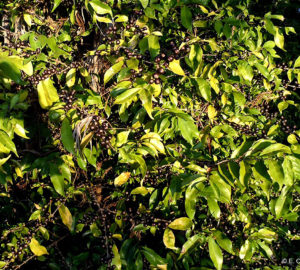At Hacienda El Roble, seventeen roasters from ten countries cupped thirty-one arabica varietals, all grown in a remarkable garden right there on the farm. The garden contains seventy-two different coffee varieties and species, and the thirty-one samples we cupped were harvested the second and third week of January, processed in identical fashion: depulped, naturally fermented for sixteen hours, washed and then sun-dried on raised beds. They were kept in parchment for two and a half months and then milled and vacuum packed for two additional months. Basically, they were processed using the best practices available in Colombia.
Hacienda El Roble is an organic farm owned by Oswaldo Acevedo. The average farm in Colombia is two hectares; Hacienda El Roble is over three-hundred. It’s huge. Virmax, a noted progressive coffee exporter, has been working with Hacienda El Roble since June of last year.
The farm employs a full staff of scientists, agronomists, and managers who all maintain this beautiful land. When you’re in Mesa de los Santos, be sure to stay at the hotel located in the middle of the farm. You can currently find Hacienda El Roble coffees at George Howell’s Terroir and Stumptown Coffee.
We sat down with Stumptown hunk Ryan Brown and asked him about his experience at the farm. Once he stopped talking about the food, things got really serious:
“This is my third time at Hacienda El Roble. It’s inspiring how much they’ve changed their operation from my first visit to my second visit. They invested in new pulping equipment, the drying systems were updated, and the warehouse now has dehumidifiers. I would say cup scores jumped three to five points. Presently this farm mostly grows the common Colombian cultivars: Caturra, Bourbon and Typica. It’s exciting to cup all of these unique and rare garden varietals and to imagine offering micro-lots of them from Hacienda El Roble.”
The 72 coffee plants at El Roble yield almost exactly enough coffee to hold a cupping event such as this (500-1,000 grams). Uncommon Colombian varietals like Wush Wush, Gesha 62, Icatu, Moca have been taken out of the garden and into small plots in the last three years…
Of the thirty-one varietals cupped at the Cupping Extravaganza, the top ten scored were as followed:
1. HR-61: 91.28
2. Anormalis: 89.94
3. HR-62: 89.78
4. Mibirizi 87.5
5. Moca: 87.22
6. SL-28: 86.5
7. Coffee SP: 85.56
8. Caturra Erecta: 85.5
9. Chinchina 21: 85.5
10. HR-2a: 84.94
HR-61, HR-62, and HR-2a are all unclassified varietals obtained ten years ago from Cenicafe. When they were planted they were labeled as Liberica Excelsa and Racemosa but later found to have been mislabeled. HR-61 cups like a Gesha. The aroma, flavor profile and complexity tastes just like Gesha, but it’s improbable that it’s actually a Gesha. Only until you decode the coffee genome can you find out the true identity of these rare varietals.
“It would be nice,” says Klaus Thomsen, owner of The Coffee Collective in Denmark, “to have a box of five of these varietals to sell to consumers. It would be great to show that you can achieve big differences in taste from the same farm.”
#Slurparama brought together cuppers from around the planet and introduced most of them to a new world of varietals and possibilities for Colombian coffee. Caturra, Catuai, Bourbon, Maragogype: these are all delicious Colombian varietal staples. But Wush Wush? Chinchina 21? We’ll look forward to future offerings from Hacienda El Roble and keep an eye on Virmax and all of the projects they’re working on.
Other fun facts:
- 124 CATALOGED BIRD SPECIES
- 3 ORGANIC CERTIFICATIONS JAS EU NOP
- 120 PERMANENT WORKERS
- 500+ SEASONAL WORKERS
- FULL BENEFITS / BONUSES FOR PICKING QUALITY CHERRY
- 3 DOGS
- 59,000 SHADE TREES / 1 ROBLE (OAK TREE)
- 39,809 COFFEE SHRUBS
- 12,407 CATURRA TREES
- 4,000 BOURBON TREES
- 3,156 HR-62 TREES





































